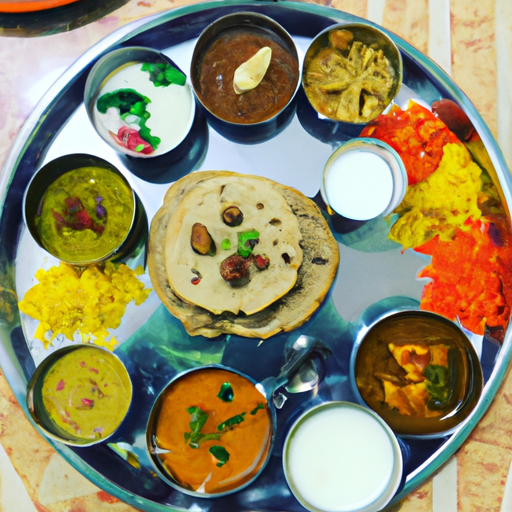Experience the rich flavors and vibrant cultural heritage of India through its food. Delight in the aromatic spices and regional specialties that define Indian cuisine. But beyond being a culinary delight, food also plays a significant role in Indian rituals and traditions. From birth ceremonies to wedding celebrations, each occasion is marked by specific dishes and symbolic ingredients. Discover how food binds generations, expresses love, and signifies auspicious beginnings in the captivating world of Indian culture.

Religious Festivals and Food Offerings
Importance of food offerings in religious rituals
Food offerings play a vital role in religious rituals in India. As a way to pay homage to deities and seek their blessings, devotees prepare and offer a variety of dishes during festivals and religious ceremonies. These offerings symbolize devotion, gratitude, and the act of sharing one’s abundance with the divine. It is believed that the deities partake in the essence of the food and bless the devotees in return.
Types of food offered in different festivals
Different festivals in India are associated with specific types of food offerings. For example, during Diwali, the festival of lights, sweets like laddoos and kheer hold immense significance. On the other hand, during Navratri, a nine-night Hindu festival dedicated to the goddess Durga, devotees observe fasts and offer dishes made of buckwheat flour, potatoes, and popular festive drinks like “thandai.” Pongal, a harvest festival in South India, is celebrated with a dish of the same name made of freshly harvested rice, lentils, and jaggery.
Symbolism behind food offerings
Food offerings carry deep symbolism in religious rituals. The act of preparing and presenting food is considered an expression of devotion and love towards the divine. The ingredients used, their preparation, and the method of offering are all symbolic gestures. For instance, the use of aromatic spices like cardamom and saffron represents purity and auspiciousness. The act of offering food on banana leaves signifies respect for the Earth and all its creations. By partaking in these offerings, it is believed that devotees receive the divine blessings and experience spiritual nourishment.
Sacred Rituals and Dietary Restrictions
Significance of purity and sanctity in food
In Indian culture, the concepts of purity and sanctity are deeply ingrained in food practices. The idea is to maintain cleanliness and avoid impurities in the preparation and consumption of food. Rituals like washing hands before cooking, using fresh ingredients, and ensuring a clean cooking environment are common practices to uphold the sanctity of food.
Religious dietary restrictions in Hinduism
Hinduism, being a diverse religion with various sects and subsects, has different dietary restrictions. Some sects follow a strict vegetarian diet, abstaining from consuming meat, fish, and eggs. This is based on the principle of ahimsa (non-violence) and the belief in the interconnectedness of all life forms. On the other hand, some sects may allow the consumption of certain types of meat, emphasizing moderation and specific rituals associated with it.
Customs and beliefs related to vegetarianism
Vegetarianism has a strong presence in Indian culture, and it is often associated with religious and spiritual beliefs. Many Hindus and Jains follow a vegetarian diet as a way to practice compassion towards animals and promote a harmonious relationship with nature. Vegetarian dishes are widely available and appreciated, even in non-religious contexts, making India a paradise for vegetarian food lovers.

Weddings and Celebratory Feasts
Elaborate food preparations for weddings
In Indian weddings, food holds a significant place and is meticulously prepared to cater to the tastes and preferences of the bride, groom, and their families. Elaborate menus are planned, including a variety of appetizers, main courses, desserts, and beverages. A wedding feast may consist of multiple courses and can feature both vegetarian and non-vegetarian delicacies.
Traditional dishes served at weddings
Indian weddings are known for serving a wide array of traditional dishes that vary based on regional and cultural preferences. Some popular dishes include biryani, a fragrant rice dish cooked with meat or vegetables and aromatic spices, butter chicken, a creamy and flavorful chicken curry, and gulab jamun, a sweet syrup-soaked dessert made of deep-fried milk solids. These dishes are prepared with great care and expertise to ensure a memorable culinary experience for the wedding guests.
Feeding rituals and customs during weddings
Feeding rituals and customs hold great significance in Indian weddings. One such ritual is the “Joota Chupai,” where the bride’s sisters and friends playfully hide the groom’s shoes and demand a ransom in return. Once the shoes are returned, the groom is expected to feed the person who returned them with sweets or money. This tradition symbolizes the love, respect, and care between the families and fosters a sense of unity and joy.
Fasting and Special Occasions
Religious and cultural significance of fasting
Fasting is a common practice in many religions and cultures in India. It holds spiritual, mental, and physical significance. Fasting is seen as a way to cleanse the body, discipline the mind, and strengthen one’s devotion and willpower. It is also believed to purify the soul and bring one closer to the divine.
Types of fasting observed in different communities
Different communities observe different types of fasting based on their religious and cultural beliefs. For example, Muslims observe the month-long fast of Ramadan, where they abstain from food and drink from sunrise to sunset. Hindus observe various fasts like “Karva Chauth,” where married women fast from sunrise to moonrise for the well-being and longevity of their husbands. Similarly, Jains may observe fasts during specific days or festivals as a way to purify their body and mind.
Traditional food prepared for fasting
During fasting, certain food restrictions are followed, and specific dishes are prepared to cater to those restrictions. Dishes made from ingredients like fruits, nuts, milk, and non-grain flours like buckwheat and water chestnut are common during fasting periods. Sabudana khichdi, a dish made from tapioca pearls, is a popular choice. The use of certain spices and herbs is limited during fasting to align with the dietary restrictions.

Food as Prasad and Blessings
Meaning and importance of Prasad
In Hinduism, Prasad refers to food that has been offered to deities during religious ceremonies or rituals. After the food is blessed, it is distributed among the devotees as a form of divine blessing. Prasad is considered sacred and is believed to carry the divine energy and grace of the deity. By consuming Prasad, devotees seek spiritual blessings and a closer connection with the divine.
Common types of Prasad offered in temples
Different temples offer different types of Prasad depending on the deity being worshiped and the regional customs. Laddoos, pedas, and modaks (sweet dumplings) are commonly distributed as Prasad. In South India, offerings like pongal, a sweet and savory dish made of rice and lentils, and tamarind rice are popular. Prasad is usually simple yet delicious, prepared with love and devotion to honor the deity.
Blessings associated with consuming Prasad
Consuming Prasad is believed to bring blessings and divine favor to the devotees. It is considered a sacred act that nourishes not only the body but also the soul. Devotees believe that by consuming Prasad with devotion and gratitude, they receive the divine blessings and protection of the deity. Prasad is seen as a way to purify oneself from sins, seek spiritual growth, and experience a sense of inner peace and contentment.
Regional Food Traditions
Distinctive food traditions across Indian states
India’s regional diversity is reflected in its food traditions. Each state has its unique culinary practices and flavors, shaped by its geography, climate, and cultural influences. From the spicy and aromatic cuisine of North India to the coconut-based delicacies of the South, the culinary traditions across the country are as diverse and vibrant as its people.
Traditional recipes and cooking methods
Traditional recipes are passed down through generations, preserving the authentic flavors and cooking methods of each region. In North India, tandoor ovens are used to cook bread and meats, resulting in smoky and flavorful dishes like naan and tandoori chicken. In South India, the art of tempering spices and grinding fresh masalas creates rich and distinct flavors in dishes like sambar and dosas. Each region has its own unique spices, techniques, and ingredients that contribute to the rich tapestry of Indian cuisine.
Historical influences on regional cuisines
The regional cuisines of India have been heavily influenced by historical events, invasions, and cultural exchanges. The Mughal era introduced Persian and Central Asian flavors to the North, resulting in dishes like biryani and kebabs. The coastal regions were influenced by Portuguese, Dutch, and British colonizers, leading to the incorporation of spices like red chilies and tamarind in their cuisine. These influences have contributed to the wealth and diversity of Indian regional food traditions, making it a treasure trove of flavors.
Harvest Festivals and Agrarian Customs
Celebrations of agricultural abundance
Harvest festivals are an integral part of Indian culture, celebrating the abundance of agricultural produce and paying gratitude to nature and farmers. Festivals like Makar Sankranti, Baisakhi, and Onam mark the harvest season and are celebrated with great enthusiasm. These festivals serve as a reminder of the close connection between humans, the Earth, and the food we consume.
Traditional dishes prepared during harvest festivals
During harvest festivals, specific dishes are prepared using newly harvested grains, fruits, and vegetables. For example, during Makar Sankranti, sesame and jaggery-based sweets like til laddoos and gur rewari are made. Pongal, a dish made of freshly harvested rice, is a staple during the harvest festival in South India. These dishes not only represent the bountiful harvest but also invoke blessings for prosperity and well-being.
Rituals and customs honoring farmers and nature
To honor farmers and nature during harvest festivals, various rituals and customs are followed. In some regions, farmers perform puja (worship) of their agricultural tools and cattle, seeking blessings for a fruitful harvest in the upcoming season. Unmarried girls may also participate in rituals like swinging on swings decorated with flowers and offering prayers for a good husband and a happy married life. These customs symbolize the deep gratitude and respect toward nature and the interconnectedness of all living beings.
Gifting Food and Hospitality
Importance of food in Indian hospitality
Hospitality is an integral part of Indian culture, and food plays a crucial role in expressing warmth and generosity towards guests. In India, it is believed that the way to someone’s heart is through their stomach. Be it a welcoming gesture for a guest or a way to celebrate special occasions, offering food is considered an essential part of Indian hospitality.
Traditional Indian snacks and sweets as gifts
When it comes to gifting, traditional Indian snacks and sweets hold a special place. During festivals or special occasions, people exchange boxes of sweets like ladoos, barfis, and jalebis as a token of love and good wishes. Savory snacks like namkeens and chivdas are also popular gifts, showcasing the diverse flavors and textures of Indian cuisine. These edible gifts bring joy and sweetness to relationships and are cherished by the recipients.
Etiquette and customs of sharing food
Sharing food in India is not just a mere act; it is often accompanied by various etiquettes and customs. For example, when sharing a meal, it is considered respectful to serve food with the right hand, as the left hand is traditionally associated with hygiene purposes. In some cultures, guests are encouraged to eat to their heart’s content, and hosts will continue to offer more food until the guest is satiated. By following these customs, Indians aim to create a sense of warmth, abundance, and inclusiveness while sharing a meal.
Food as Medicine in Ayurveda
Ayurvedic principles of food and health
Ayurveda, the ancient Indian system of medicine, emphasizes the connection between food and health. In Ayurveda, food is considered a powerful tool for preventing and treating diseases, promoting overall well-being, and maintaining a balance between mind, body, and soul. Ayurvedic principles guide individuals on the proper selection, preparation, and consumption of food to support their unique constitutions.
Healing properties of spices and herbs
Spices and herbs are an integral part of Ayurvedic cooking and are valued not only for their flavor but also for their healing properties. Turmeric, for example, is known for its anti-inflammatory and antioxidant properties, while ginger aids digestion and strengthens the immune system. Cumin, coriander, and fenugreek are common spices used for their digestive benefits. These spices are skillfully combined to create delicious and health-promoting meals.
Traditional remedies and practices
Ayurveda offers a vast array of traditional remedies and practices to address specific health concerns. From simple home remedies like drinking warm water with lemon and honey to alleviate cold symptoms to the use of ghee for skincare, Ayurveda encompasses a holistic approach to healing. Ayurvedic practices such as Panchakarma, a detoxification treatment, and Ayurvedic massages are also employed to restore balance and enhance overall well-being.
Street Food and Social Gatherings
Street food culture in India
Street food is an integral part of Indian culinary culture and plays a significant role in social gatherings. The streets of India are lined with food stalls and carts offering a diverse array of flavors and textures. From the tangy and spicy chaat to the savory and addictive samosas, street food caters to all palates and budgets, making it accessible to people from all walks of life.
Popular street food dishes and snacks
Some of the most popular street food dishes in India include pani puri, crispy and hollow puris filled with spiced water, and pav bhaji, a buttery and spicy vegetable curry served with soft bread rolls. Vada pav, a street-style burger with a potato fritter, and dosas, thin and crispy fermented rice and lentil crepes, are also widespread and loved by locals and tourists alike. Street food not only provides a burst of flavors but also serves as a social hub, fostering connections and conversations.
Role of food in social bonding and community
Food acts as a powerful catalyst for social bonding and community building in India. It brings people together, transcending barriers of language, religion, and social status. Whether it’s a street food stall where strangers strike up conversations over a plate of chaat or a community feast celebrating a festival, food serves as a unifying force. It creates opportunities for people to connect, share stories, and build lasting relationships that go beyond the realm of cuisine.
Indian cuisine is a mesmerizing tapestry of flavors, rituals, and traditions. From religious festivals to weddings, fasting to street food, every aspect of Indian life is intertwined with food. It is through food that Indians express their love, appreciation, and devotion to the divine, their gratitude to nature and farmers, and their hospitality and warmth towards guests. So, next time you savor the flavors of Indian cuisine, remember that you are not just experiencing a delicious meal but also immersing yourself in the rich tapestry of Indian rituals and traditions.
